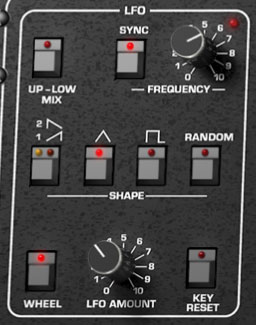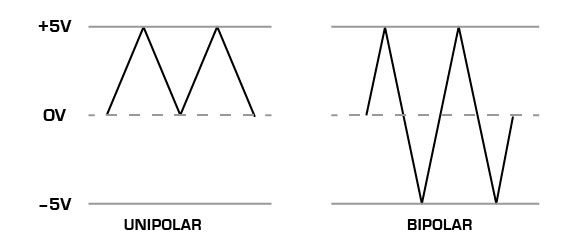LFO is short for "Low Frequency Oscillator." LFO's are used for cycling modulation and operate below audible hearing range. The LFO can be routed to the oscillators for pitch modulation (aka vibrato) or pulse-width modulation of the pulse wave, filter cutoff for "wah wah" effects, or the amp section for tremolo effects.
In this chapter, we'll cover both the LFO and Mono-Mod sections because they work in conjunction.
LFO
Up-Low Mix- This is a unique feature of the original instrument that mixes the LFO outputs of the Upper and Lower layers. The main intention of this isn't necessarily obvious: if you'd like to apply the same modulation to both the Upper and Lower layers, set the LFO controls as desired on one layer, then enable Up-Low Mix and disable all mod waveforms on the other layer. This effectively allows one layer's LFO to affect both layers. (Make sure to set the LFO Amount knob and destination buttons in the Mono-Mod section the same for both layers.)
Up-Low Mix can also be used to create unique LFO mod waveshapes by combining waveforms and differing mod frequencies from each LFO. This works particularly well when Sync is enabled, because the LFO's will move together in logical subdivisions for unusual but congruent mod waveshapes.
Sync- When the Sync switch is enabled, LFO frequency will lock to host tempo when using P-10 within DAW software, or to the current tempo in the top menu bar when using the standalone version. The Frequency knob will snap from 8 beats up to 1/64th note triplets.
Frequency- The Frequency knob sets LFO speed , from 0.05 to 31.5 Hz (with Sync switch off). The LED beside the Rate knob flashes at the current modulation rate, and visually indicates the curve of the current mod waveform.
Shape- Sets the LFO mod waveform. The waveforms include unipolar sawtooth and ramp, bipolar triangle, unipolar square, and bipolar random. In case you're not clear on the difference between unipolar and bipolar waveforms, let's clarify. For this sake of these examples, we'll assume that LFO Amount (i.e. depth) is set to max.
Unipolar waves cycle between 0 and 5V. If we were applying this to pitch, this means the pitch would begin at nominal level (same as no modulation) at the start of the mod cycle, then go up to max mod setting, then return to nominal pitch.
Bipolar waves cycle between -5V and 5V. If we were applying this to pitch, this means the pitch would begin at the max negative mod amount at the start of the mod cycle (pitch would be lower than nominal amount), then go up to max mod setting, then to max negative again, and so forth.
Here's why P-10 (and most analog synths) choose unipolar vs. bipolar for different mod wave types:
In the case of triangle or sine waves, bipolar is preferred, because these are most frequently used for pitch modulation, i.e. vibrato. In this situation, it's desirable to have the pitch go up and down "around" the base pitch, because the ear tends to hear the overall frequency of a vibratoed sound as the center frequency. If we used a positive unipolar wave, the pitch of the note would sound sharp (because its pitch center would lie halfway between 0V and 5V at about +2.5V).
When using square wave mod, unipolar is generally preferred, again because of how it affects pitches when modding oscillators. This is because the "bottom note" remains constant (and the same as the note with no mod applied), while the "top note" interval gets larger as more mod is applied. This makes it easy to set up a modulation between the base pitch and fixed interval (such as a major 2nd, minor 3rd, major 3rd, fifth, etc.). Conversely, a square wave with bipolar mod makes setting a musical interval difficult, because as the mod amount is increased, the lower note gets lower and the higher note gets higher - making for something of a "moving target."
P-10's saw and ramp waves are unipolar, which has the same "always beginning at base pitch" effect. It's not as important here, since saw and ramp wave mod is usually used more as an effect, but it is usually preferable if mod is applied to filter cutoff, because it most likely will mean less dialing in of the cutoff frequency to compensate for the modulation.
LFO Amount and the Mod Wheel - Important, please read this
On the original Prophet-5, mod amount was controlled strictly by the mod wheel (just like a Minimoog), so there was no way to save the mod amount when patches were stored. This was a real bummer, because every time a new patch that used LFO mod was selected, you'd have to set the mod wheel to the appropriate position - whiiiich kind of defeated the purpose of the Prophet-5's then super-innovative digital patch storage. Sequential Circuits acknowledged this shortcoming when they created the Prophet-10 by adding an LFO Amount knob in the Mono-Mod section. This allowed users to store an initial mod amount, however it's important to understand that the mod wheel and Mono-Mod LFO Amount knob work additively, and Cherry Audio P-10 stores the setting of the mod wheel with patches, so be aware if one or the other (or both) is turned up.
Wheel- Enables and disables mod wheel controller data. When disabled, LFO depth is solely controlled by the LFO Amount knob.
LFO Amount- Sets the initial amount of LFO modulation routed to the destination buttons to its right.
Key Reset- Resets the LFO modulation cycle when a new key is pressed (but no other keys are currently held). This is particularly useful when the Sync button is enabled, and allows rhythmically synced modulation. It's most useful with the saw, square, and random waves.
Mono-Mod
The Mono-Mod section determines how the LFO control signals are routed.
Source Mix- Determines the Mono-Mod section source, allowing selection between the LFO or noise source, or a mix thereof.
Destination- These toggle buttons determine how Mono-Mod is routed. They can be used singly or in any combination. Destinations are as follows:
Freq A/B- LFO modulates the pitch of Oscillator A, Oscillator B, or both.
PW A/B- LFO modulates the width (aka, duty-cycle, see Oscillator A and B section for more info) of the pulse wave of Oscillator A, Oscillator B, or both. Pulse-Width Mod (PWM) has no effect on the ramp and triangle waveforms. PWM is the key to creating the famous glistening Prophet string sounds!
Filter- LFO modulates filter cutoff frequency.
Amp- LFO modulates overall amplitude, aka, volume. This mod destination wasn't available on the original instrument (but our lead sound programmer, who we'll call "James," will be happy because this lets him create fabulous electric piano patches).


